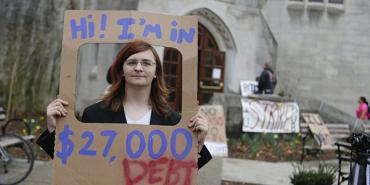Like so many aspects of our lives that have been affected by the coronavirus, student debt has gotten worse. With the economy reeling and businesses closing or slowing down, many student loan borrowers who have lost income are unable to make their monthly loan payments, and they are bracing themselves for long-term consequences.
To minimize the damage, the AFT, in partnership with the Student Borrower Protection Center, is circulating information and tips to help borrowers through the crisis with tools like income-driven repayment plans and hardship deferment. The AFT is also working with lawmakers to ensure that any future coronavirus relief legislation builds on the current legislation to provide substantial student loan relief.
Big picture problem
Student debt in the United States—now clocking in at $1.6 trillion—is already a burden for millions of people and a significant drag on the economy. Forty-five million people owe an average of $38,000 on their student loans, and another borrower goes into default every 26 seconds.
Already stretched and struggling, countless student loan borrowers over the weeks and months ahead will be hard-pressed to meet basic needs like housing, food and medical care. Student loan payments to the federal government will doubtless fall to the bottom of the list.
For that reason, student debt relief was a key point of discussion in the U.S. Senate’s coronavirus stimulus bill. The final bill, passed March 25, did include provisions to put most federal student loan payments on hold for six months, without accruing interest and while still counting those months toward Public Service Loan Forgiveness. The bill also halts involuntary collections on most federal student loans for six months.
Many Democrats, including Senate Minority Leader Chuck Schumer (D-N.Y.) and Sen. Elizabeth Warren (D-Mass.), had hoped to go further by not just delaying but canceling all payments owed during the crisis and giving each borrower a minimum of $10,000 in loan forgiveness. The AFT signed a joint statement with 19 other progressive organizations supporting the Democrats’ proposal.
“In response to the COVID-19 pandemic and its devastating economic impact, it’s crucially important to include federal student loan debt cancellation as a part of any economic stimulus,” reads the statement. “Now more than ever, we must ensure that all Americans can prioritize their health and that of their neighbors. Student loan relief is an essential factor in making that possible, and this proposal will make it a reality.”
The House of Representatives will take up the bill March 27, and another stimulus package is expected; student borrower advocates will continue to push for more relief.
Meanwhile, President Trump has promised to waive federal student loan interest and defer payments, as the Senate bill dictates. This development, says AFT President Randi Weingarten, is a direct result of collective pressure from education advocates like the AFT. “We’ve helped change the narrative,” she says, but warns that “we also have to make sure the Trump administration actually meets the promises it’s made.”
Loan by loan
While policymakers wrangle with the best way to mitigate damage from the double whammy of student loan debt and a coronavirus economy, everyday people just want to know how they’re going to make their loan payments and avoid default—even with the six-month relief measure, which is expected to activate automatically on existing loans.
A webinar sponsored by the AFT and the Student Borrower Protection Center outlines more details. It describes income-based repayment plans, which allow borrowers to pay only what they can afford, and notes that, in some cases, monthly payments can be as low as zero dollars and still count toward eventual loan forgiveness. It dives into details about who qualifies for this plan—whether defaulted loans qualify, for example, and how to bring loans up to date. It explains how to continue to qualify for Public Service Loan Forgiveness—the program that forgives student debt for qualifying people who work in public service and make their monthly loan payments for 10 years—even when making those required monthly payments is impossible.
More specific to the coronavirus, the 20-minute webinar offers information for people who have been laid off or furloughed, with details about how to document these changes so that they will qualify for income-based repayment. There is also general information about financial hardship deferment or forbearance, loan consolidation, and loan rehabilitation for people whose loans are in default.
“At the end of the day we’re trying to ensure that people have the protections that they need,” Weingarten told those who tuned in to the webinar live. At the same time, she said, the AFT wants to “move the ball a little bit further to make sure that during this crisis those loan payments are canceled or mitigated.”
[Virginia Myers]

